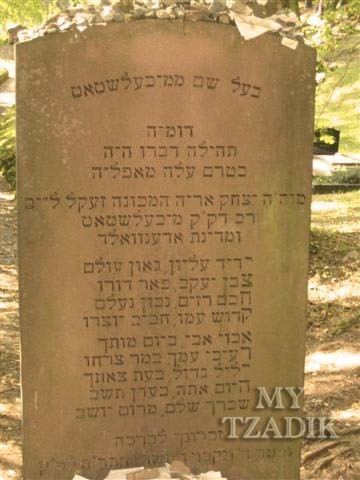 | ||
Bloch ernest baal shem for violin orchestra
Baal Shem (Hebrew: בַּעַל שֵׁם, pl. Baalei Shem) in Hebrew meaning "Master of the Name", refers to a historical Jewish occupation of certain kabbalistic rabbis with knowledge of using names of God in Judaism for practical kabbalah healing, miracles, exorcism and blessing.
Contents
- Bloch ernest baal shem for violin orchestra
- History
- Hasidism
- Baal Shem practice and Kabbalah
- Amulets and Practical Kabbalah
- Recorded Baalei Shem
- Contemporary legacies
- References
History
The unofficial title was given by others who recognised or benefited from the Baal Shem's ability to perform wondrous deeds, and emerged in the Middle Ages, continuing until the early-Modern era. Baal Shem were seen as miracle workers who could bring about cures and healing, as well having mystical powers to foresee or interpret events and personalities. They were considered to have a "direct line" to Heaven evoking God's mercies and compassion on suffering human beings. In Jewish society, the practical theurgic role of Baalei Shem among the common folk was a mystical institution, contrasted with the more theosophical and ecstatic Kabbalistic study circles, who were isolated from the populace. The Baal Shem, the communal Maggid preacher, and the Mokhiakh (מוֹכִיחַ/preacher) of penitence were seen as lower level unofficial Jewish intelligentsia, below contract Rabbis and study Kabbalists.
The activity of Baalei Shem among the community, as well as the influence of kabbalistic ideas, contributed to the popular belief in Tzadikim Nistarim (Concealed Righteous). Hasidic tradition records Elijah Ba'al Shem of Chelm in the 16th century, founding a "Nistarim" mystical brotherhood to offer physical and spiritual encouragement to the Jewish populace, making him the first Baal Shem, and from which movement Hasidism later emerged.
Hasidism
A few people received the title of Baal Shem among Eastern and Central European Ashkenazi Jewry. The name is most well known in reference to the founder of Hasidic Judaism, the Baal Shem Tov (Besht – "Master of the Good Name") – Israel ben Eliezer (1698–1760) in Ukraine. However, this is misleading. The Baal Shem Tov started public life as a traditional Baal Shem, but with his teachings of Hasidism, introduced a new way into mystical thought and practice. His role is distinguished from other, predominantly earlier, Baal Shem by the addition of Tov – Good to his title. Hasidism popularised esoteric Kabbalah into a social mysticism movement. The new mystical role of the Hasidic Tzadik leader replaced Baal Shem activity among the populace, combining Kabbalist and Maggid, and replacing practical kabbalah with the Tzadik's divine intercession. The 1814–15 Praises of the Besht sets the Baal Shem Tov's teaching circle against his remaining occupation as travelling Baal Shem.
Baal Shem practice and Kabbalah
The "Name" referred to in "Master of the Name" is the most holy Four-Letter Name of God or Tetragrammaton. In Jewish tradition, this Name was pronounced only by the High Priest on Yom Kippur. With the destruction of the Second Temple by the Romans in the year 70 CE, the true pronunciation was presumably lost. (Jews today do not pronounce the Name out loud, and substitute another Hebrew word, usually Adonai, in prayers and texts.) In some accounts, a Baal Shem was believed to have re-discovered the true pronunciation, perhaps during deep meditation, and could use it in magical ways to work miracles. Some stories say he pronounced it out loud, others say he visualized the Name in his mind. He also used the names of angels in this way.
Amulets and Practical Kabbalah
There are two differentiated streams in Kabbalah, that leading Kabbalists separated over concerns of illegitimate use of Practical Kabbalah:
The leading Kabbalist Isaac Luria (1534–1572) forbade people of his time to use Practical Kabbalah. As the Temple in Jerusalem is not standing, and no one possesses the ashes of the Red Heifer, people are unable to become pure. Without these things, he said, Practical Kabbalah is very damaging. Yitzchak Ginsburgh describes the connection of Jewish amulets to Practical Kabbalah:
Amulets are on the border between Practical Kabbalah and an external manifestation of Kabbalah, such as name calculation. There is a source for amulets in the Torah. When a great sage writes Holy Names, without pronouncing them, on parchment and puts it into a container which is worn by the recipient, it can possess healing and spiritual powers. At the beginning of the Baal Shem Tov's life, since he was a healer, he used amulets. Sometimes the amulet works because of the faith of the recipient in the spiritual power of the amulet. At the end of his life, the Baal Shem Tov never wrote the Names of God, only his own signature, Yisrael ben Sara or Yisrael ben Eliezer. This was the ultimate amulet given by the Ba'al Shem Tov.
The Sages teach us that whoever receives a coin from the hands of Job (a tzadik) receives a blessing. This is the source in the Talmud that receiving a coin from a great tzaddik brings with it a blessing. Thus we see that there are amulets that are permissible. The determining factor is the righteousness and intentions of the person giving the amulet.
Recorded Baalei Shem
A rare group of people have been recorded as holding the title of Baal Shem. The first recorded person to receive the title was Eliyahu of Chelm.
Other Baalei Shem (besides the above) include:
Contemporary legacies
The name "Baal Shem" mainly survives in Jewish surnames of people descending from Ba'ale Shem such as Balshem, Balshemnik and Bolshemennikov.
In recent years, some new age Jewish groups have revived the term as referring to the Jewish equivalent of a shaman or folk healer.
